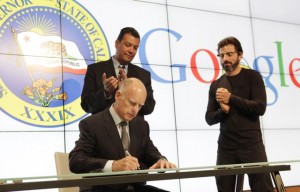
By Jerry Hirsch, Los Angeles Times –
LOS ANGELES — Having a hard time parallel parking? Press a button on a touch screen and let the car park itself.
Want to stay a safe distance from the car ahead while traveling 65 mph? Switch on adaptive cruise control and let a radar-linked computer handle the accelerator, slowing and speeding your vehicle to keep pace.
The assisted-driving technologies that just a few years ago seemed so futuristic are already here, bringing the auto industry one step closer to a George Jetson-like world where drivers may no longer have to drive.
“We are looking at science fiction becoming reality in a self-driving car,” Gov. Jerry Brown said Tuesday when he signed a bill that would allow self-driving cars on California’s roads.
Although that might be some years off, automakers already are pouring millions of dollars into systems that hand more control of a vehicle to a complex network of sensors and computers. Features such as collision avoidance systems that sense a potential crash and trigger the brakes or an alert that tells drivers they are wandering into adjacent lanes are making their way into more cars every year.
Industry, traffic and insurance experts believe that the advances are beginning to transform driving in a way that will reduce accidents and injuries.
“This is the future,” said Adrian Lund, president of the Insurance Institute for Highway Safety. “Vehicles are designed to protect people when crashes happen, but it would be even better to prevent crashes from happening altogether.”
Drivers are just beginning to experience these new features, and it’s not always without a hitch.
That’s what happened when Los Angeles attorney Randy Garrou test-drove the “intelligent parking assist” feature in a Toyota Prius v hybrid. The system backed the station wagon into a lamppost.
“If that had been a human, the person would have been wiped out,” said Garrou, who along with the salesman escaped injury. The experience left him thinking that such autonomous driving features “aren’t ready for prime time.”
An occasional glitch isn’t stopping the auto industry and technology companies from speeding into the self-driving car segment.
Google co-founder Sergey Brin said autonomous cars could be functional and safe for operation on public streets within a few years. Think autopilot.
But the concept of handing over the steering wheel to a computer is making some people ill at ease.
“It freaks me out,” said Michael Sigman, a writer and music publisher who lives in the Laurel Canyon section of Los Angeles. “It is totally fascinating, and I would like to see how they work, but the idea of thousands and millions of people ‘not’ driving around in these things is very scary.”
Despite the uneasiness, there is some evidence that the early autonomous driving functions are already improving safety.
Volvo’s City Safety, a low-speed forward collision avoidance system, is one feature that has been shown to be effective. The system is designed to help a driver avoid rear-ending another vehicle in slow-moving traffic.
The Highway Loss Data Institute compared insurance claims for the 2010 Volvo XC60 SUVs equipped with a forward collision avoidance system with claims for other 2009-10 mid-size luxury SUVs that don’t have the technology. The Volvos had 27 percent fewer property damage liability claims. They also had fewer claims for bodily injury.
Acura and Mercedes-Benz vehicles equipped with another type of collision avoidance systems that work at higher speeds had 14 percent fewer damage claims than those that didn’t have the technology, according to an institute study.
The auto insurance industry estimates that if all passenger vehicles were equipped with just four sensor-based alert systems — forward collision warning, lane departure warning, blind spot detection and adaptive headlights that pivot in the direction of travel based on steering wheel movement — about 1 in 3 fatal crashes and 1 out of 5 injury crashes could be prevented or have their severity lessened.
Google believes that despite any mishaps with autonomous features working their way into vehicles now, completely self-driving vehicles will be safer and more convenient than cars driven by humans.
“Look at all the people who don’t have access to transportation today but still need to live their lives,” said Anthony Levandowski, head of Google’s Self-Driving Car Project.
“There is a lot of opportunities for making cars safer, more convenient and more accessible,” Levandowski said. “The fact that you have to drive your car all the time is kind of a bug in the car itself.”








Having a car that drives itself can’t be much worse than riding with some of the people I know. It might be a huge improvement.
I can’t wait for this! I just drove a long way on the interstate and semis tried to kill me by cutting in front of me at the last minute going 5 mph slower. Can anyone tell me what the new side panels between their wheels do? Are they to keep little cars from being buffeted by the wind or are the to increase gas milage or some other reason I haven’t considered?